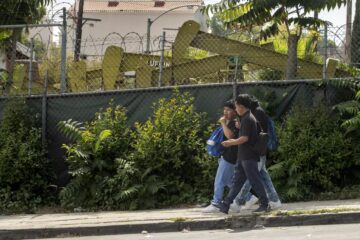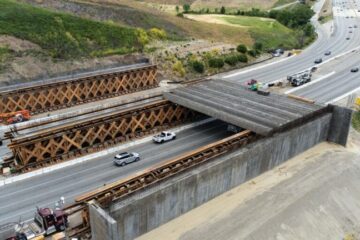Amid soaking storms, California turns to farmland to funnel water into depleted aquifers
Flooded Central Valley fields are being used to replenish groundwater
Source of this article, the Los Angeles Times, March 21, 2023
As storms have drenched Northern California, water diverted from the swollen Sacramento River has been flowing from a canal and pouring onto 200 acres of farmland.
For more than a month, the water has spread across fields, forming shallow pools, then percolating slowly into the earth.

In Yolo County, near the town of Dunnigan, officials from the state Department of Water Resources are working with farmers on a project to recharge groundwater. Storm water is allowed to percolate into the ground to replenish aquifers, while providing habitat for birds.
This farm northwest of Sacramento, which has previously produced rice, is being used to replenish groundwater. It’s one of a growing number of sites across the Central Valley where landowners and local water managers are using farmland to take advantage of this year’s heavy rain and snow by capturing water and putting it underground.
Once applied to the fields near the town of Dunnigan, the water quickly sinks into the soil and makes its way through sediment to the aquifer. Measurements in nearby wells show that groundwater levels have risen.
“Within a matter of a couple of days, we see improvement in the water table,” said David Schaad, a farmer and president of the Dunnigan Water District. “It’s wonderful to see.”
Seeking to encourage similar efforts across California, Gov. Gavin Newsom recently signed an executive order suspending permit requirements for groundwater recharge in many areas. The order, which lasts until June 1, will make it easier for local water districts and farms to route river flows to fields and other sites where the water can boost depleted aquifers.
The push to use farmlands for managed aquifer recharge has been praised by experts who say it can help the state combat overuse and become more resilient as climate change unleashes more intense dry spells and floods.
But some have criticized the governor and state water regulators for what they view as a failure to plan ahead. They say the current rush to flood farmlands risks washing harmful contaminants into aquifers, and more work needs to be done to identify those properties best suited for recharge.
Much of the Central Valley was once a vast floodplain fed by the rivers that flow from the Sierra Nevada. Many areas of the valley that once flooded and naturally allowed for water to percolate into aquifers have been transformed into farmland, bisected by webs of canals and levees.
Decades of overpumping from agricultural wells have left groundwater severely depleted in much of the Central Valley, leading to subsidence, or the sinking of the ground, which has caused damage to canals and other infrastructure. Falling water levels have also left rural residents with dry wells.
State officials say projects such as the one in Dunnigan can begin to address the long-term water deficits.
“This is how we’re going to start to recover from the drought, get water back into our drought buffer, our storage bank,” said Tim Godwin, a technical and policy advisor in the state Department of Water Resources’ Sustainable Groundwater Management Office. “It’s important that when we have excess flows, we replenish these systems, so when the next drought comes along, we’re prepared for and are able to weather those conditions.”
For its recharge effort, the Dunnigan Water District has received “surplus” Sacramento River water from the Tehama-Colusa Canal. Some of the water has been released into a creek to replenish the aquifer; other flows have been routed to the privately owned farm.
“If we can take the surface water when it’s available and put it in the ground, that’s good stewardship — of land, of the aquifer,” said Bill Vanderwaal, the district’s manager.
Even before the winter storms, the Dunnigan Water District secured water last year to flood fields in an effort focused on replenishing groundwater and creating habitat for shorebirds.
“When we started flooding up that field, the birds were there like that,” Vanderwaal said, snapping his fingers. “You could see all the white egrets.”
The district secured water for that project with help from the Nature Conservancy, which has been supporting groundwater recharge efforts that also create shallow-water habitat for migrating birds.
“This is a great example of what we need to do more of,” said Rodd Kelsey, associate director of the Nature Conservancy’s water program in California. He said the goal should be to “spread that water out on tens of thousands, if not hundreds of thousands, of acres.”
Measurements in wells near the farm show that water levels have risen between 35 and 40 feet since October, Vanderwaal said.
“It reaches the aquifer much faster than I imagined,” Schaad said. “It’s amazing.”
The inflows to the aquifer hold promise to boost water levels in the wells of homes and surrounding farms that produce almonds, tomatoes and grapes.
In other parts of the Central Valley with permeable soils, growers have invested in infrastructure to send storm water to vineyards and orchards, successfully replenishing groundwater while continuing to produce crops.
Newsom has called for increasing the amount of water used to recharge aquifers as part of his plan for adapting to more extreme conditions with climate change.
To that end, the State Water Resources Control Board recently approved a plan to divert floodwater from the San Joaquin River to replenish groundwater in farming areas. The state Department of Water Resources says it has given local water agencies $68 million to support 42 recharge projects.
In many areas, agricultural irrigation districts already have constructed basins where water can be routed for groundwater recharge. Leaders of agricultural water districts have been focusing on replenishment as one way to lessen the required cuts in pumping they will face by 2040 under the state’s Sustainable Groundwater Management Act.
Researchers warn that even if California succeeds with more recharging, it won’t provide nearly enough water to eliminate the severe deficit in areas where aquifers are in overdraft.
Studies have projected that large portions of the Central Valley’s irrigated croplands will need to be left dry to comply with the groundwater law. Researchers with the Public Policy Institute of California estimated in a recent report that by 2040, the average annual water supplies for agriculture could decrease by 20%. They estimated that as much as 900,000 acres of farmland may need to be fallowed.
The governor’s order is a positive step, said Helen Dahlke, a professor in integrated hydrologic sciences at UC Davis. She hopes the order may help “trigger some new movement to revise what system we have in place to get these high flows diverted for groundwater recharge.”
The current regulatory system is cumbersome and bureaucratic, requiring water agencies to hire consulting firms and lawyers, Dahlke said. Many applications are rejected the first time, she said, and it typically takes months for an agency to get a permit approved.
Dahlke said she hopes state officials speed up the process. The system should strike a balance between maintaining needed river flows for the environment and replenishing aquifers, she said.
“Really taking advantage of those wet years when they occur is key in order to secure more water for future years,” Dahlke said. “We have a groundwater aquifer that can take three times the amount of water that we can store in surface water reservoirs, and it’s protected from evaporation.”
The Central Valley’s more than 8 million acres of irrigated farmland are well-connected to canals and can serve as spreading grounds, while allowing for farming to continue, Dahlke said.
“It’s a very cheap method. It’s probably the cheapest one we can think of in terms of water storage and water management,” she said.
Dahlke said the state should set a goal of recharging 1 million to 1.5 million acre-feet of water during wet years — roughly two to three times the total annual consumption by Los Angeles.
The state remains far from that target. The State Water Board says that since December, it has signed off on diverting about 790,000 acre-feet for groundwater replenishment as well as supplies for wildlife refuges.
Some water advocacy groups criticized the governor’s order, saying that while they agree on the importance of recharge, they’re concerned that the lack of oversight may lead to flooding fields where pollutants in soil could be pulled down to the aquifer. They cited concerns about nitrates from fertilizers, which pose health hazards and already pollute wells in many rural areas.
“Once you contaminate a groundwater basin, it’s at least decades to clean it up, generally,” said Michael Claiborne, directing attorney for the group Leadership Counsel for Justice and Accountability. “It’s very, very costly. And in our rush to get water into the ground, we’ve got to make sure that we’re not making it so we can’t use the water that’s already there.”
The governor’s order includes some protections, including banning recharge on dairy lands, but Claiborne said the protections don’t go far enough. His group, together with Clean Water Action and Community Water Center, urged state officials to plan so that the next time ample floodwaters are available, they have detailed maps showing where recharge can be conducted safely to protect drinking water.
Karla Nemeth, director of the Department of Water Resources, said state officials know areas where there are potential water quality issues and will be working to ensure there is recharging in “the right places that will enable us to protect water quality.”
With the intense rains and heavy snow, the governor’s order sends a signal to encourage landowners and water districts to capture floodwater and store it underground, Nemeth said.
“It’s crucial for the future of the valley to get this groundwater recharge moving,” she said. “And I think that there is an important role for agriculture to play.”



0 Comments